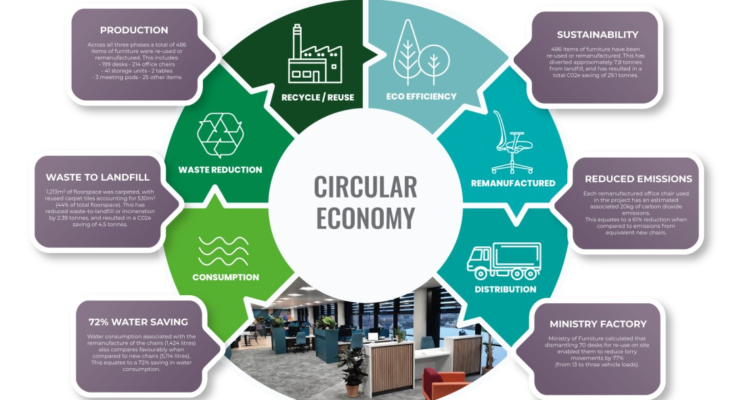With the increasing popularity of budget and eco-friendly ideas, the use of circular economy principles is gaining recognition in office designs. The Economic principles in office design prioritize eco-efficiency, waste reduction, remanufacturing and recycling resources highlighting environmental awareness. This economic model is parallel to the ‘take-make-dispose’ approach.
Instead these Economic principles in office design stand for ‘Refuse-Recycle-Reform-Reduce-Reuse’ purposes. The circular Economic principles in office design embrace the long-term use of resources to optimize their value and then recycle them for the benefit of nature. This approach requires office designers to produce innovative and sustainable designs for an eco-conscious future.
Office interior designer in Noida suggests incorporating aesthetics and functionality for a circular economic workspace. By including Economic principles in office designs, firms can create a sustainable, efficient and enriching working environment.
This article will introduce you to the basics of circular Economic principles in office design. It also helps you to implement these principles in your workplace to minimize waste, optimize resource utilization, and reduce their environmental footprint.
Contents
Strategies to Promote Circular Economy Principles in Office Design
There are many strategies office designers can implement to promote circular economic principles in workspace design. Organizations should be involved in reusing their resources and creating efficient processes. From a simple step like reducing paper usage to more sustainable furniture, designers can renovate their offices. Here are five distinct strategies to promote Economic principles in office design:
Waste Reduction Strategies
Organizations should promote the use of waste reduction strategies to minimize waste generation. Offices can be promoted as more eco-friendly using sustainable and flexible furniture designs and the establishment of efficient recycling systems. Economic principles in office design can be incorporated through readily accessible recycling bins and to encourage employees to participate in the cause.
Adaptive Reuse of Existing Structures
The primary purpose of the circular Economic principles in office design is to build an adaptive effective reuse system for the employees. Designers can reuse the existing structures of office design with minor alterations. In this way, organizations can increase the long-term usability of the built environment.
These changes will be cost-friendly and speed up the transition to a circular economy. Adaptive reuse involves repurposing the office to meet future goals. Technology can play a crucial role in repurposing the existing structures per the economics principle in office design.
Regenerative Design practices
The regenerative design practice is a holistic methodology of Economic principles in office design. This system involves a strategy to reduce firms’ impact on the environment and contribute towards ecological balance. Some of the best examples can be the use of renewable energy sources prioritizing sustainability and harmonizing the construction of buildings with their ecosystem. This system not only benefits waste management and sustainability but also ensures the well-being of employees.
Renewable Energy Sources
Businesses can utilize modern sustainable energy sources to reduce the organization’s carbon footprints and emissions. Modern technologies and innovations have paved paths for the promotion of Economic principles in office design. Solar panels and wind turbines for instance are good renewable energy mediums for offices.
These sources will benefit the organization in two primary ways. Firstly, they can provide clean and sustainable power to the offices. Secondly, it will reduce their economic reliability on non-renewable sources which are getting increasingly high-priced. Repurposing energy in spaces is one of the new innovative ideas in this field.
Adopt Modular Solutions
Office designers should engage aesthetics and Economic principles in office design for a visually appealing sustainable workspace. Implementing modular designs like utilizing adaptable furniture will reduce the repurchasing debt of the organization. Another method to adopt modular solutions can be upcycling old and unused structures for a creative and fresh purpose. This strategy embraces adaptable and easy-to-repair furniture, which can be swiftly restructured to meet evolving office needs.
Benefits of Circular Economic Principles
Circular Economic principles in office design are transforming the workplace by embedding sustainability. All the strategies mentioned above are beneficial for office employees as well as nature. The Economic principles in office design bring efficiency to the workplace while keeping costs in check. Here are a few of the benefits of circular Economic principles in office designs:
Reduce Waste
Circular economy utilizes recycled and reused structures in office designs. These strategies help in reducing waste generation by the organization daily. Reducing waste generation also has effects on environment awareness and cuts costs. Remanufacturing the resources contribute to pollution control and promote a healthier planet.
Reduce Carbon Emissions
Circular economic workplace minimizes their carbon footprint and carbon emissions through design efforts. Using sustainable materials and layouts optimizes the resource value and leads to long-term savings.
These practices promote a healthier, toxic-free workplace environment. The Economic principles in office design prioritize product layouts with future refurbishment in mind. A circular economy lowers the carbon footprints by minimizing the need to produce new materials which cause carbon emissions.
Save Money
Implementing circular Economic principles in office design lowers the re-purchasing cost for the company. It is the best way that can lead to cost savings in businesses. By reducing waste and recycling or repurposing the resources, organizations can easily save money. Interior designers need to rethink their designs for more sustainable and modular solutions for the offices.
Promote Sustainability
Sustainability is the practice of optimizing resources in a way that the present generation can fulfill their needs without compromising the requirements of future generations. Circular Economic principles in office designs promote sustainability and eco-consciousness to the fullest. Sustainable practices are good for the ethical corporate image that attracts environmentally conscious clients.
Conclusion
In this article, we explored some strategies to implement circular Economic principles in office designs and their benefits. The circular economy is a vast and new field for office and interior designers. It is a journey towards waste reduction, sustainability and a cost-saving path for businesses.
In office designs, one can incorporate adaptable, reusable and remanufactured furniture to lower their carbon emissions. The sustainable and eco-friendly nature of the company helps in increasing employee satisfaction and aligns with the client’s beliefs.
If you gained new insights from this article, explore our blog, Gimkit, for more enlightening content.



